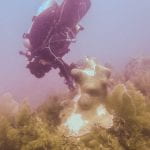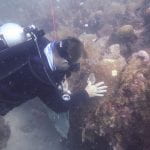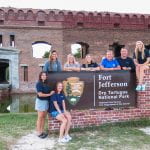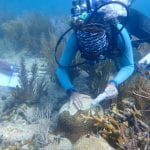FORT LAUDERDALE/DAVIE, Fla. – The world’s coral reefs are in peril.
Various factors – from climate change to pollution runoff to diseases – have led to a sharp decline in the number of healthy corals, both locally near Florida as well as across the globe. For many years, research scientists at Nova Southeastern University (NSU) have been studying corals to understand not only what is killing them, but what we can do to mitigate those impacts.
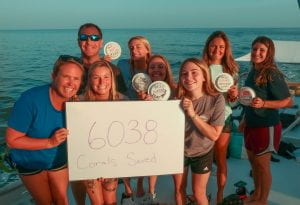 To that end, an emergency response mission to save corals in Dry Tortugas National Park was recently conducted and the results exceeded researchers’ expectations, with more than 6,000 disease-affected coral colonies being treated.
To that end, an emergency response mission to save corals in Dry Tortugas National Park was recently conducted and the results exceeded researchers’ expectations, with more than 6,000 disease-affected coral colonies being treated.
Stony coral tissue loss disease (SCTLD), a devastating marine pandemic that has spread throughout several areas of the wider Caribbean, was first documented in the Dry Tortugas region by National Park staff in late May. The disease has been spreading through Florida’s Coral Reef Tract from its origin near Miami since 2014. It affects at least 25 susceptible coral species, with mortality rates from 66% – 100%.
“Because the disease is still in the early stages within the Dry Tortugas, we knew quick action was needed,” said Karen Neely, Ph.D., a research scientist at NSU’s Halmos College of Arts and Sciences.
So, an intervention mission, funded by the National Oceanographic Atmospheric Administration’s (NOAA) Coral Reef Conservation Program and the National Fish and Wildlife Federation’s emergency coral fund, was launched. Led by Neely, scientists from NSU and Florida Atlantic University’s (FAU) Harbor Branch Oceanographic Institute teamed up to carry out the largest coral disease intervention effort to date.
Over the course of the 10-day mission, the team surveyed and treated disease-affected corals in an area the size of 146 football fields. Disease-affected corals were treated with a recently developed topical antibiotic paste that is known to halt the disease lesions and increase corals’ chances of survival.
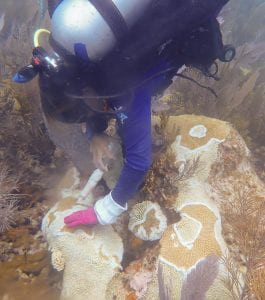 “This is akin what humans put on a rash or other skin infection,” Neely said. “This approach has proved successful in other areas, so we knew this was the best chance we had at stopping the spread of the disease in the Dry Tortugas.”
“This is akin what humans put on a rash or other skin infection,” Neely said. “This approach has proved successful in other areas, so we knew this was the best chance we had at stopping the spread of the disease in the Dry Tortugas.”
Neely said this intervention method has been successfully used since 2019 at targeted sites throughout the Florida Reef Tract and in other parts of the Caribbean. Prior to this expedition, intervention efforts in Florida totaled just over 4,000 treated corals, with two-year survival rates of treated corals exceeding 96%.
The 6,038 corals treated on the Dry Tortugas mission represented 27 species, including several that are nearly extinct elsewhere in Florida. Some of these corals are the largest and oldest animals in the state, and they were treated in order to preserve one of Florida’s most spectacular coral reef ecosystems. Neely attributed the success of the mission to “a highly capable team of trained coral scientists and a focused mission of intervention. A great research platform and perfect weather conditions helped too.”
“The number of corals lost to this new disease is staggering and will restructure coral communities in South Florida for decades,” said Dr. Joshua Voss, a collaborator on the mission from FAU Harbor Branch. “This expedition demonstrates that targeted concerted intervention efforts, led by champions like Dr. Neely, can give us hope for conserving some of Florida’s most impressive coral reef habitats.”
Coral disease intervention efforts within Dry Tortugas National Park will be continued by NPS staff, and efforts throughout the rest of the Florida Keys will be continued by Neely and the research team.
This research was made possible by the NOAA-NFWF Coral Emergency Response Fund, grant #0302.21.073586
Be sure to sign up for NSU’s RSS feed so you don’t miss any of our news releases, guest editorials and other announcements. Please sign up HERE. You can also follow us on Twitter @NSUNews.
###
About Nova Southeastern University (NSU): At NSU, students don’t just get an education, they get the competitive edge they need for real careers, real contributions and real life. A dynamic, private research university, NSU is providing high-quality educational and research programs at the undergraduate, graduate, and professional degree levels. Established in 1964, the university includes 15 colleges, the 215,000-square-foot Center for Collaborative Research, the private JK-12 grade University School, the world-class NSU Art Museum Fort Lauderdale, and the Alvin Sherman Library, Research and Information Technology Center, one of Florida’s largest public libraries. NSU students learn at our campuses in Fort Lauderdale, Fort Myers, Jacksonville, Miami, Miramar, Orlando, Palm Beach, and Tampa, Florida, as well as San Juan, Puerto Rico, and online globally. With nearly 200,000 alumni across the globe, the reach of the NSU community is worldwide. Classified as having “high research activity” by the Carnegie Foundation for the Advancement of Teaching, NSU is one of only 59 universities nationwide to also be awarded Carnegie’s Community Engagement Classification, and is also the largest private institution in the United States that meets the U.S. Department of Education’s criteria as a Hispanic-serving Institution. Please visit www.nova.edu for more information.
About NSU’s Halmos College of Arts and Sciences and Guy Harvey Oceanographic Research Center: The college provides high-quality undergraduate and graduate education programs in a broad range of disciplines in the natural sciences, humanities, social sciences, and the arts. Halmos College faculty, researchers, staff, and students pursue studies and investigations in all of these fields and in interdisciplinary projects. Excellence in teaching, research, and community engagement are at the forefront of the College’s many initiatives. The Guy Harvey Oceanographic Research Center hosts cutting edge research in the marine sciences focusing on the biology, conservation, and physical aspects of the tropical and subtropical ocean environments. Please visit hcas.nova.edu for more information.
MEDIA CONACT
Joe Donzelli, APR | Office of Media Relations
Nova Southeastern University
954-262-2159 (office) | 954-661-4571 (cell)
jdonzelli@nova.edu | www.nova.edu | @NSU_Joe
